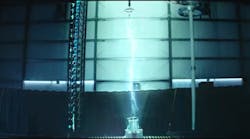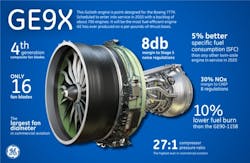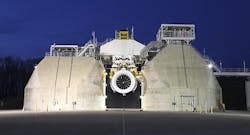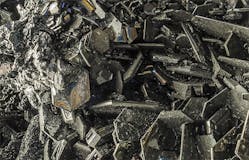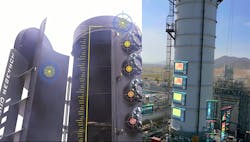To Todd Wetzel, GE’s thermal systems technology leader, rocket science isn’t all that impressive compared to jet engine science.
“Lots of people think of rocket engines as being something really hot and really extreme,” the thermal dynamics expert says, “but the thing about rocket engines though is that they never fire for more than about two or three minutes, even at the most extreme, before you get to shut them off, whereas a jet engine must endure similarly high temperatures, but for thousands and thousands of hours and thousands of flights and still be very reliable.”
It’s truly amazing what jet engines have to go through, and you can read more about that inour feature on GE’s jet engine testing facility.
What I learned from my visit, and the several interviews I’ve had with some of General Electrics’ top minds, is that the conglomerate is all about reliability and predictability. Those aren’t the sexiest of values in an age of buzzwords and instant gratification, but what do you expect from a company founded by Thomas Alva Edison? The light bulb is the most iconic symbol of innovation, so GE doesn’t really need to bend to popular sentiment.
But in recent years GE seems to at least want to be liked more. For the series finale of "30 Rock," a show that lampooned its former parent company as as a morally ambiguous capitalistic cult, GE ran an ad showing the company's favorite moments.
On "30 Rock," GE created Greenzo, America's first nonjudgmental business, friendly, environmental advocate. His catch phrase: "The free market will solve global warming -- if that even exists."
Image courtesy NBC Universal
Since this statement, GE's achieved this strategy often through several clever and sometimes downright bad ass commercials, and most recently through a campaign in April to enlighten the public on how cool its heat-resistant ceramic material composites are via a limited edition hot sauce packaged in advanced jet engine materials.
“Obviously with jet engines, heat makes a big difference,” says Todd Alhart, communications and public relations manager for GE Global Research. “The hotter you can run your jet engine, the more efficient it can be. By telling that story in conjunction with hot sauce, it helps people relate to what we’re doing in the industrial space.”
In conjunction with Thrillist and High River Sauces, GE created the 1032 Kelvin Pepper Sauce, which uses the hottest peppers in the world -- the Carolina Reaper (1.5 million Scoville Heat Units) and the Moruga Scorpion (2 million SHU) -- to achieve a condiment just a tad more mellow than a mouthful of pepper spray.
Click Here for a Chance to Win Your Very Own Bottle!
To drive home how hot the sauce is, the bottles are encased in a silicon carbide shell, the same CMC used in GE’s LEAP and GE9X engine that make them incredibly fuel efficient. The caps are nickel alloy, the metal the CMC is replacing, which have a lower melting point and thus require more cooling.
“Silicon carbide can withstand much higher temperatures than any high strength engine we can make a jet engine out of,” Wetzel explains. It’s 20% better, in fact, and one-third the weight of metals otherwise used in the engines. “That means we can run the engine hotter, which makes it more fuel efficient. It also means we don’t need to use as much coolant to protect it, which also makes it efficient.”
Having tasted the sauce, I can attest will make your tongue feel like a rocket has used it as a launch pad. Holding the lightweight cylinder in my hand, it’s hard to imagine it could contain such explosive temperatures that reach more than 2,400°F.
Wetzel says toughness is definitely one of the material’s strong suits.
“When most people think ceramics, they think plates and vases,” he says. “You have to baby those things or they’ll shatter into a million pieces. These are not brittle like that.”
The diamond-like silicon carbide can also be used in solar inverters.
Photo: GE
GE created America’s first jet engine during World War II, and Wetzel concedes there’s not much to improve upon in the mature technology. These CMCs, invented by GE Krishan Luthra, have found a way to do that. Orders for the LEAP engine have exceeded $100 billion; the GE9X, which began testing in April, already has $29 billion in orders.
“It takes a very bold technology like these materials to make an improvement in a machine that is otherwise very refined,” Wetzel says.
And because you can’t exactly feel the inside of a jet engine during takeoff, it takes a very bold hot sauce to show just how far the technology has come.
Cloud-Based BBQ
The foray into hot sauce wasn’t the first time GE used food science to demo its products. The conglomerate was already quite adept at making the incomprehensible more palatable.
Last year at Austin’s South by Southwest festival, a place where everyone from avante garde artists to major corporations gather to amaze the masses with technology, music, and oddities, General Electric chose to present its Predix Industrial Internet platform via a barbecue. It is Texas, after all, and what better way to make industrial software exciting in an environment soaked in good tunes and better booze, and covered in lasers and daisy dukes?
The 12-ft. high vertical “Super Smoker” had internal sensors hooked up to the analytical software tool to show in real time one of Austin’s top pitmasters and a GE software scientist the internal humidity and temperature of the barbecue chicken and brisket incubating inside.
Alhart says the question GE wanted to answer was, “Can the Industrial Internet make for better barbecue?”
“One thing the pitmaster really valued was the ability to check the condition of meat without having to lift the lid off the smoker, which actually disrupts the temperature and humidity,” Alhart recalls.
He says the experiment worked, as Predix alerted the pitmaster to higher-than-normal humidity at one point, which was traced back to pieces of wood with excessive moisture, something that could have thrown off the meat alchemy by altering the consistency. It was a great moment for carnivores everywhere, but there was more to GE’s demo than creating better barbecue.
“It was really a way for us to talk about our science and technology through the prism of barbecue sauce,” Alhart says.
In this case the demonstration highlighted their new analytics platform in a tangible way that excites all the senses. Whether its jet engines or a rack of ribs, the message is still the same:
“If we could really understand the sensors in a machine, what’s happening and what the conditions of the parts and environment are, we can really get much more precise,” Alhart explains. He says this can help companies predict when to take equipment in for maintenance and plan in advance for that downtime, not get surprised by it. Using Predix asset performance management solution, an airline that shaves a modest 1% of fuel costs would save millions of dollars.
Working Hard or Hardly Work?
Speaking of surprises, GE wants the world to know it has prepared for every occasion:
Yes, a maelstrom of cephalopods is unlikely, but for the most inclement weather, GE did produce the octobrella, which is constructed from the carbon composite used in its jet engine fan blades, and high tensile pongee polyester.
These examples could be seen as an aging company trying too hard to seem relevant. Or they could be a ruse to distract us from their plan for global domination.
Or more likely, GE has evolved from General Electric to Genuinely Eccentric, now more closely resembling the mad scientist mentality of Nikola Tesla than Edison’s “99% perspiration” attitude. They actually caught lightning in a bottle and made it look easy, for crying out loud:
“We have a great culture here and scientists who do really important work that is so critical to how the world works,” Alhart says. “If you come work for GE, you’re going to do really important work that’s consequential to the world, and you’re going to have a lot of fun doing it.”
That’s not to say any of GE’s 305,000 employees don’t work hard. That effortlessness could be because they actually like their jobs. As Alhart explains about the people he works with at GE Global Research headquarters, “they love what they do” and are “young at heart.”
My visit to Peebles to check out the GE9X engine corroborated this, as everyone I met there was warm and knowledgeable, excited to tell their story, the reason they wake up in the morning excited to go to work.
When I asked Alhart if all the commercials and hot sauce and octobrellas were a way to be cool, and to attract boomer-replacing Millennials who may otherwise choose some pseudo-Google office with bean bag chairs and Red Bull in the water coolers, he had this to say:
“We’re the oldest industrial research lab to be established in the United States. I think we’re every bit as cool and hip as we were when we started.”
At this point, "30 Rock" would have probably flashbacked to the time GE publicly electrocuted a homicidal elephant at Coney Island... but why focus on the past when the future is just so damn cool?










